1-Chloro-1,1-difluoroethane
Agent Name
1-Chloro-1,1-difluoroethane
CAS Number
75-68-3
Formula
C2-H3-Cl-F2
Major Category
Solvents

Synonyms
Chlorofluorocarbon 142b; Ethane, 1-chloro-1,1-difluoro-; Propellant 142b; 1,1-Difluoro-1-chloroethane; 1-Chloro-1,1-difluoroethane; CFC 142b; Chloroethylidene fluoride; Difluoro-1-chloroethane; FC142b; Fluorocarbon 142b; Fluorocarbon FC142b; Freon 142; Freon 142b; Genetron 101; Genetron 142b; Gentron 142B; Gentron 142b; Hydrochlorofluorocarbon 142b; Isotron 142b; Monochlorodifluoroethane; R-142b; HCFC-142b; [ChemIDplus] UN2517
Category
Chlorofluorocarbons
Description
A colorless gas shipped as a liquid under its own vapor pressure; [CAMEO]
Sources/Uses
Used as an aerosol propellant, blowing agent, refrigerant, and chemical intermediate; [HSDB] Used as a solvent; [Hawley] Used mainly as an intermediate with limited use as an aerosol propellant and possible use as a blowing agent and refrigerant; [AIHA]
Comments
In confined space spill, may displace air and act as simple asphyxiant; Evaporating liquid can cause frostbite; At high concentrations, may sensitize heart to arrhythmias; [ICSC] May cause irritation; May cause rapid suffocation; [MSDSonline] It has anesthetic effects at high concentrations; Threshold for cardiac sensitization in rats is 50,000 ppm; [AIHA]
Biomedical References
Exposure Assessment
MAK
1000 ppm
Lethal Concentration
LC50 (mice) = 447,000 ppm/2h;
NFPA
burn readily
ERPG-1
10,000 ppm
ERPG-2
15,000 ppm
ERPG-3
25,000 ppm
WEEL
1000 ppm
Adverse Effects
Neurotoxin
Acute solvent syndrome
Other Poison
Simple Asphyxiant
Diseases, Processes, and Activities Linked to This Agent
Diseases
Occupational diseases associated with exposure to this agent: